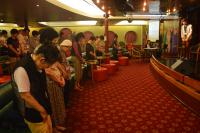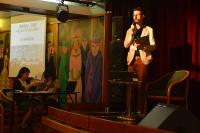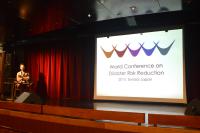Remembering Chernobyl, Apr 26, 2016 (91st Voyage)
1.45 am, 26 April 1986: Thirty years ago the world witnessed the biggest nuclear disaster in history. The reactor number 4 of the Nuclear Power Plant in Chernobyl, an industrial town in the former Soviet Union (now Ukraine), exploded because of a faulty test, releasing a cloud of radioactive substances. More than 3.5 million people have been officially registered as having been affected by the radioactive contamination. Wind spread the radioactive substances to Europe, western USSR and even as far as Japan. 120,000 people in a radius of 30 km from the reactor were evacuated, while thousands of employees and technicians, later called liquidators, desperately tried to contain the radioactive material inside a cemented sarcophagus. Many of them would die of tumors and radiation sickness.
 Participants observe one minute of silence in memory of Chernobylfs victims
Participants observe one minute of silence in memory of Chernobylfs victims
To remember Chernobyl and reflect upon Fukushima and the impact of nuclear disasters, Peace Boat marked the anniversary by hosting the event, “The tragedy of the nuclear accident – 30 years from the Chernobyl Nuclear Disaster”. During the event, Peace Boat participants watched a documentary produced by the Japanese citizens’ media outlet, OurPlanet-TV. The documentary featured children in the town of Korosten, 140 km from the reactor, who are still highly monitored for thyroid cancer, eye conditions, cardiovascular disease, scoliosis and other skeletal problems. The impact of low-dose radiation on human health is not yet conclusive, and research is ongoing. With Ukrainefs current economic depression, the government can no longer provide some of the subsidiaries it used to, like lunches that are certified free of radiation for school children in this zone.
These thirty years of radioactive exposure have created inner cracks in the cemented sarcophagus around the reactor. An international team is working on substituting the old sarcophagus with a new one, which will last for a maximum of 100 years. The work is expected to be completed in 2017 and will cost around 3 billion USD. “Electricity generated by nuclear power plants may seem very cheap, but the expenses to cope with a disaster like this are very high,” comments Matt Douglas, International Director of the 91st Peace Boat voyage and speaker at the event.
 91st Voyage International Director Matt Douglas speaks of the costs of nuclear power
91st Voyage International Director Matt Douglas speaks of the costs of nuclear power
This year also marked the fifth anniversary of the disaster in Fukushima. A magnitude nine earthquake and tsunami crippled TEPCO’s nuclear plantfs cooling system, leading to a partial meltdown of the reactor. Over 100,000 people were evacuated. No fatalities due to acute radiation effects occurred in Fukushima and in contrast with Chernobyl, the majority of the radionuclides were transported towards the Pacific Ocean by the prevailing winds. The consequences of this disaster could have been very different if the wind was blowing in another direction. Yet, the impact continues to affect communities and land in Fukushima and surrounding regions, and tens of thousands of people are not yet able to return to their homes.
In 2015, Peace Boat organized a series of events to commemorate the 4th anniversary of the Fukushima nuclear disaster. In particular, as part of the Japan Civil Society Organization Coalition on DRR, it was involved in a series of Fukushima-related events in parallel with the United Nations World Conference on Disaster Risk Reduction (WCDRR) in Sendai, an event organized every five years by the UN. This conference was significant as the first time that nuclear disasters were also taken on as part of the agenda, instead of focusing only on natural disasters. “With this conference, we wanted to collect the voices of citizens and NGOs, and bring them forward to the high level WCDRR,” explains the 91st Voyage International Director. He worked together with other NGOs to invite to Japan worldwide activists from Mexico, Russia, India, Bangladesh and Brazil, amongst other countries. These representatives, many of whom come from countries which have or are considering nuclear power, connected with civil society groups in Japan to understand what is happening in Fukushima. “We took them to Fukushima during the anniversary and also the exclusion zone to meet local groups who are assisting with the recovery and measuring radiation, and evacuation centers with temporary housing. So they could have a sense of the situation in Fukushima and how it is even now,” explains Matt Douglas.
“One accident in one country can affect other countries. So the lessons learned have to be discussed around the world,” continues Matt Douglas. Indeed, the Global Conference on Disaster Risk Reduction for Civil Society was also the chance to launch the booklet “10 Lessons from Fukushima”, a grassroots project to spread lessons learned from Fukushima with the world. It was created by the Fukushima Booklet Publication Committee, which includes Peace Boat, the Japan NGO Centre for International Cooperation (JANIC), Fukushima Beacon for Global Citizens Network (FUKUDEN) and CWS Japan. The booklet is now available in more than 10 languages, particularly languages spoken in the countries where nuclear technology may soon be exported, like Turkey, Bangladesh and India. “Japan and other countries of the Global North are racing to export their technologies and nuclear plants to the Global South. We feel that it is important for the people living in these countries to learn the experience of Fukushima citizens and make informed decisions. We believe that nuclear energy is not worth the risks. People in Fukushima were told that the nuclear power plant was safe. They were betrayed,” explains Matt Douglas.
 The Booklet, “10 Lessons from Fukushima,” by the Fukushima Booklet Publication Committee has been translated into several languages.
The Booklet, “10 Lessons from Fukushima,” by the Fukushima Booklet Publication Committee has been translated into several languages.
Twenty percent of the worldfs major earthquakes happen in Japan, and Japan had also more than fifty nuclear reactors, the worldfs highest concentration. Two power plants have been reopened; one of them is located in the island of Kyushu, quite near to Kumamoto – the site of another recent devastating earthquake. The Japanese government wishes to restart more nuclear power plants, against the wishes of the majority of the population.
Japan currently imports about 84% of its energy requirements. Peace Boat believes that Japan should invest more in renewable energy, taking advantage of the huge potential for geothermal and hydroelectricity energy and rethinking how society uses energy. Moreover, Japan recently deregulated the electricity retail market, which means that Japanese people now have the opportunity to choose to buy electricity from a company that produces electricity in the way they want. “We should not force the next generations to take care of our nuclear waste. I think we should find out how to generate electricity in a more clean way. Now, Japanese people can opt to source their electricity from companies that offer renewable energy. With the right investments and public support, this could be the beginning of reshaping of the energy mix in Japan,” comments Matt Douglas.
Participants of Peace Boat 91st Voyage will have the opportunity to learn about renewable energy by visiting a geothermal power station in Iceland and by attending the talks of the guest educators onboard.
The Fukushima Booklet is available for free download and use through its website and Facebook page.
 Matt Douglas, the International Director of the 91st Voyage describes what happened 30 years ago in Chernobyl and five years ago in Fukushima.
Matt Douglas, the International Director of the 91st Voyage describes what happened 30 years ago in Chernobyl and five years ago in Fukushima.
